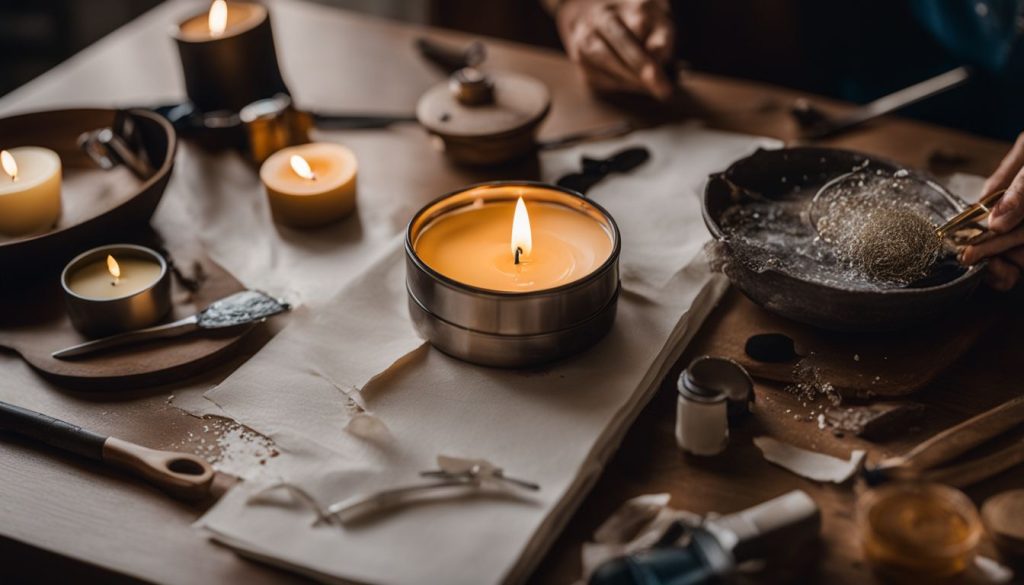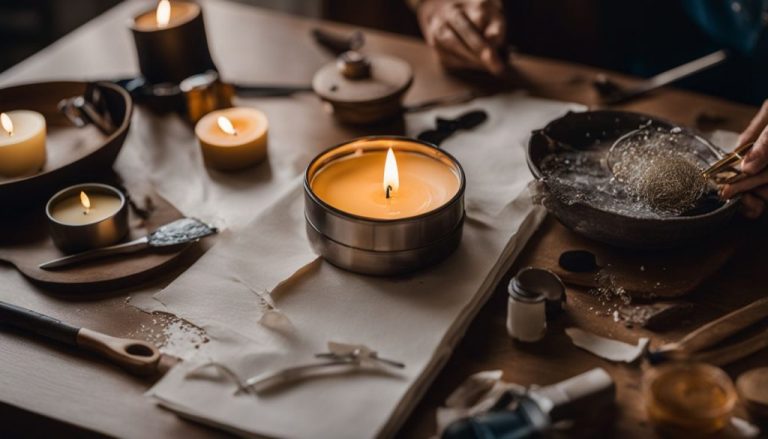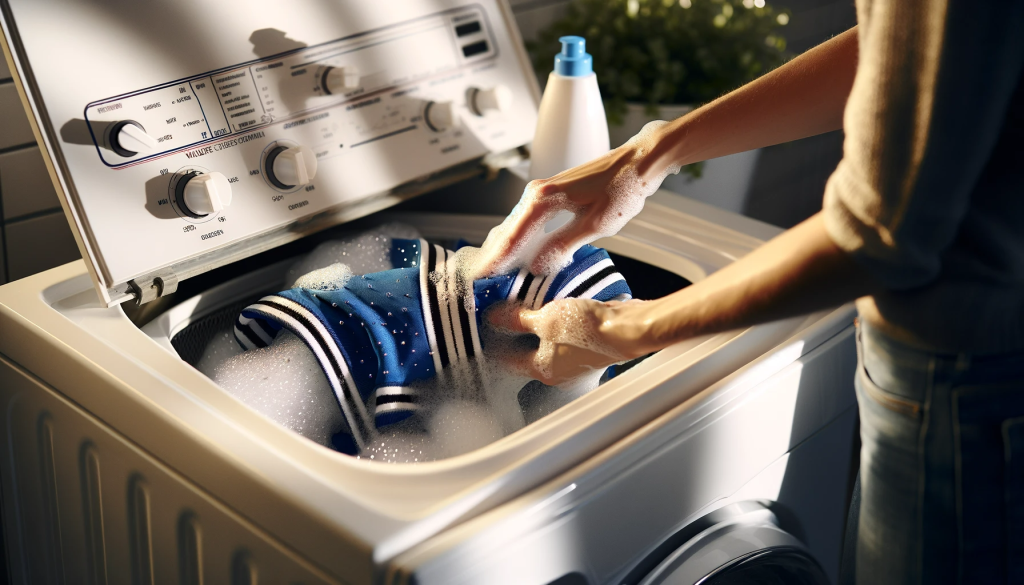Discover how simple household items can turn a wax mishap into a quick fix with our expert tips. From the gentle heat of a blow dryer to the frosty chill of your freezer, these techniques ensure your tablecloths remain pristine and ready for your next candlelit dinner. Explore these solutions and more household essentials at InktasticMerch.
Candlelit dinners that fill the air with romance can quickly take a turn for the worse when wax drips onto your tablecloth. Surprisingly, frozen wax is easier to scrape off than its softened counterpart. Dive into our blog, a goldmine of straightforward and effective techniques to banish candle wax stains from your tablecloth. Stay with us, and we’ll guide you through the process!
Key Takeaways
- Use a blow dryer set to medium heat to soften wax on your tablecloth, then dab it up with paper towels before laundering.
- For stubborn stains, place a towel over the area and apply a warm iron to lift the wax from the fabric.
- Freeze your tablecloth to make the wax brittle and easy to chip away; treat any residual stains with vinegar or detergent after.
- Slowly pour boiling water to loosen and dissolve wax from tablecloths, and follow up with a wash for best results.
- Launder washable tablecloths through a combined process: freeze, scrape, soak in an oxygen-based cleaner overnight, and machine wash to remove all wax traces.
Common Methods for Removing Candle Wax From a Tablecloth

Getting rid of persistent candle wax from your tablecloth needn’t be troublesome; numerous reliable methods can revive your linens. From the gentle warmth of a blow dryer to the unexpected effectiveness of freezing, each technique provides a distinct way of addressing wax mishaps without harming delicate materials.
Blow Dryer Method
The blow dryer method is a standout favorite for eliminating candle wax remnants. It makes solid wax malleable, simplifying the task of removing stains from tablecloths or solid surfaces.
- Prepare your workspace by spreading the wax-stained tablecloth on a flat, heat-safe area.
- Plug in your hair dryer and select a medium heat setting to safeguard the fabric.
- Use the blow dryer to warm the wax, holding it a few inches above the cloth to prevent scorching. Move it back and forth until the wax begins to soften.
- Gently press paper towels over the softened wax to absorb as much melted wax as possible.
- Use fresh paper towels to repeat the process if needed, ensuring all excess wax is lifted from the fabric.
- Once most wax is removed, apply more heated air on any remaining stains using the blow dryer for further softening.
- Blot the softened areas with white paper towels, avoiding any color transfer onto your tablecloth while absorbing leftover residue.
- Inspect your tablecloth for remaining marks. If necessary, repeat these steps or employ additional cleaning methods.
Iron Method
Building on the gentle warmth of a blow dryer, the iron method offers a more intense heat to address wax on tablecloths. It’s a reliable strategy for handling wax spills that cling too dearly to fabric.
- Adjust your iron to a low or medium setting to prevent damage to the tablecloth.
- Lay a thin towel over the wax on your tablecloth, serving as a protective barrier between the iron and the fabric.
- Gently place the iron on the towel to help transfer the wax away from the tablecloth.
stain. Aim to warm the wax until it becomes soft enough for removal.
Boiling Water Method
Candle wax removal from a tablecloth can be hassle-free. The boiling water method efficiently melts away the mess.
- Start by scraping off as much solidified wax as possible using a spoon or butter knife.
- Boil sufficient water to submerge the stained part of your tablecloth, ensuring it’s just off boiling for best results.
- Pour the hot water over the wax stain slowly, allowing it to penetrate and soften the wax, enabling separation from the fabric fibers.
- You’ll observe the melted wax rising to the surface, indicating its efficacy.
- After pouring, gently stir the water to dislodge remaining wax bits from the cloth.
- Carefully drain the hot water and wax, being mindful of splashing to avoid burns.
- Inspect the tablecloth for wax residues or stains after most has been removed.
- If any spots remain, treat with laundry detergent and wash in warm water if the fabric permits.
- For stubborn remnants or dye stains from colored candles, blot with vinegar or stain remover before washing.
Freezer Method
If the boiling water method isn’t your preference, the freezer method offers a stark contrast by solidifying wax. This technique leverages cold to harden candle wax, simplifying its removal from your tablecloth. Here’s how to use it:
- Gently scrape off excess wax with a spoon or butter knife to avoid fabric damage.
- Fold the tablecloth flat, ensuring the waxy area fits into your freezer.
- Freeze the tablecloth for about 45 minutes or until the wax is completely hardened. This step is crucial for easy removal.
- Once hard, remove the tablecloth and peel off the brittle wax with your fingernail or a credit card edge.
- For stubborn bits, place an ice cube wrapped in a cloth over them briefly to chill further, then scrape again.
- After removing most wax, check for leftover stains. Treat these spots with a vinegar and warm water mixture before laundering.
Washer Method (for washable tablecloths)
For washable tablecloths, the Washer Method simplifies wax removal using freezing, scraping, and machine washing.
- Start by freezing the tablecloth to solidify the candle wax, making it easier to manage.
- After freezing, lay the tablecloth flat on a hard surface for easy handling.
- Use a dull knife to carefully scrape off as much wax as possible, employing gentle movements to avoid damaging the fabric.
- Apply steady and consistent pressure to lift the wax smoothly without tearing the cloth.
- Immerse your tablecloth in warm water mixed with an oxygen-based cleaner in a bucket or sink.
- Allow it to soak overnight or for several hours to loosen any remaining wax particles.
- Transfer the cloth to your washing machine with care to avoid spilling loosened wax.
- Add laundry detergent as usual for a standard wash cycle.
- Choose a warm water cycle; the heat aids in dissolving any residual wax and oils.
- Inspect the tablecloth after washing; if faint stains persist, consider soaking it again before allowing it to dry.
Tips and Tricks for Removing Candle Wax

Exploring wax removal solutions reveals an arsenal of smart techniques that go beyond the ordinary. Whether using commonplace items to tackle tough spills or innovative strategies for stubborn wax bits, these tips and tricks are poised to enhance your cleaning expertise to new levels.
Use nail polish remover or rubbing alcohol
For challenging candle wax stains on your tablecloth, try nail polish remover or rubbing alcohol. These common household solutions are excellent for addressing wax buildup that’s resistant to routine washing.
Start by softly dabbing a cotton swab soaked in acetone or rubbing alcohol on the stained area. This will help break down the wax, simplifying its removal.
Before placing the tablecloth in the washing machine, blot any leftover residue with additional nail polish remover or rubbing alcohol. This step helps lift most of the wax from the fabric, minimizing the risk of a lingering stain post-wash.
Handle these solutions cautiously, as they can act as solvents and may affect some fabrics differently.
Scrape off hardened wax with a dull knife
Removing wax from your tablecloth can be manageable. Once the wax has solidified, use a dull knife to gently lift and remove larger pieces. Avoid tugging or applying too much force, which might harm the fabric.
For any remaining stubborn residue, consider chilling your tablecloth in the freezer for about 30 minutes. The cold will make the wax brittle, making it easier to scrape off without leaving marks.
This method helps you tackle even the most persistent hardened wax spots effortlessly.
Place in freezer to harden wax before scraping
After you’ve removed as much wax as possible with a dull knife, tackle the stubborn remnants by placing the tablecloth in the freezer. Allow it to chill thoroughly, turning gooey wax into a solid that’s easier to remove without creating a mess.
Once the wax is firm, gently chip away at it with your fingers or a blunt tool like a spoon.
This freezing method is not only effective but also gentle on delicate table linens, ensuring they remain pristine. If space is limited or you need a quick solution, place ice cubes in a plastic bag.
Apply this directly to the stained area. The cold will swiftly harden the wax, making removal a breeze.
and effortlessly remove those stubborn spots without resorting to harsh chemicals that might damage the fabric of your exquisite tablecloth.
Remedy Colored Wax Stains with Vinegar
Once you’ve managed to harden and scrape away most of the candle wax, the next task is to erase any remaining colored stains. These vibrant marks from candles may seem challenging, but white vinegar often works wonders.
Create a cleaning solution by mixing one part vinegar with two parts hot water, combining them into an effective stain-removing mix.
Apply this vinegar solution directly onto the stained areas of your tablecloth or wooden furniture. Allow it to soak for a few minutes to fully dissolve the wax residue—patience is crucial here.
Once absorbed, gently rub the area with a clean cloth to lift those colorful streaks without harming your fabric or wooden surfaces. This straightforward tip ensures that any remnants left after wax removal are cleaned away, keeping your cherished items spotless and free from unattractive blemishes.
How to Remove Wax from Different Surfaces
Explore the diverse wax removal techniques designed for every surface in your home, ensuring that whether it’s your favorite tablecloth or cherished wood furniture, you’re armed with the expertise to effectively tackle those stubborn stains.
Tabletops
Candlelit dinners can enhance your dining ambiance, but spilled wax on the table can be a potential mood spoiler. Worry not, as there are effective ways to deal with candle wax on various tabletop surfaces, maintaining your furniture’s immaculate condition.
- Blow Dryer Method: Take your hairdryer and set it to medium heat to gently warm the wax spill. This will soften the wax, making it easy to wipe away from the glass tabletop.
- Iron Method: For wooden surfaces, place a thin cloth or paper towel over the waxy residue and gently press with a low-heat iron. The warmth transfers the wax onto the cloth, leaving your wood spotless.
- Boiling Water Method: For sturdy surfaces like granite or marble, use boiling water. Pour it carefully over the pooled wax to loosen it without damaging the table’s finish.
- Scraping Method: Use a plastic scraper or the edge of a credit card on stone tabletops. Work gently beneath the cooled wax to lift it off without scratching the surface.
- Wax Absorption Technique: Sprinkle baking soda on softened candle wax on metal tables before wiping. It absorbs excess oils and helps clean residue effectively.
- Vinegar Solution: After removing the bulk of candle wax from any table, address leftover spots with a vinegar and water mixture—its gentle acidity clears away remaining smudges.
- Professional Products: Using specialty cleaners made for specific materials like wood polish or stone sealant can provide that extra care while dealing with stubborn wax residue after most of it is gone.
Table Linens
Table linens add sophistication to any dining occasion, but wax stains can quickly disrupt the ambiance. Removing candle wax from tablecloths involves a blend of heat treatment and meticulous cleaning.
- Blow Dryer Method: Use a hairdryer on medium heat to soften the wax. Once malleable, gently peel away the residue with your fingers.
- Iron Method: Place a brown paper bag over the wax stain and lightly iron over it. The heat draws the wax into the paper, lifting it from your linen.
- Boiling Water Method: Stretch the stained area of the tableclothNội dung:
- Boiling Water Method: Cover a bowl securely and pour boiling water over the wax. This will melt it away, allowing gravity to perform its magic.
- Freezer Method: As a vital step, consider freezing your table linen to solidify any leftover wax after scraping. After approximately 30 minutes in the freezer, break away the cooled wax effortlessly.
- Washer Method: For washable tablecloths, once most of the solid wax is gone, wash them as per fabric care instructions using hot water to dissolve any stubborn residue.
Upholstery
Moving from table linens to furniture care, let’s turn our attention to upholstery—a frequent target for candle wax mishaps. Proper upholstery treatment calls for gentle handling and accurate techniques to prevent potential damage.
- To avert wax from embedding deeply into the fabric, tackle spills on upholstery swiftly. Quick action spares you time and effort later.
- For fresh wax spills, place an ice cube on the wax to quickly solidify it, simplifying the process of scraping it off without embedding it further into the fibers.
- Once hardened, use a dull knife or a plastic card to carefully remove as much wax as possible, applying gentle pressure to avoid fabric tears or scratches.
- For lingering wax traces, place a brown paper bag or absorbent cloth on the affected site, setting an iron on low—without steam—and gently passing it over the fabric. The heat will make the wax melt and get absorbed by the paper or cloth.
- Continue using new sections of paper or cloth until all wax has been lifted from your upholstery.
- If any stain lingers, gently dab rubbing alcohol or nail polish remover with a white cloth on it, which aids in breaking down and removing remaining color without spreading it further.
- Perform a spot test with any cleaning solution on a discreet part of your furniture to ensure the upholstery fabric remains unharmed.
- For colored wax stains, mix equal parts of vinegar and water. Carefully sponge the solution on the stain and blot it dry with a clean towel.
- After removing candle wax from upholstery, allow adequate airing time before using more cleaners to minimize any potential damage from chemical residue buildup.
Rugs and Carpeting
As we move from upholstery to rugs and carpets, adjusting our wax removal tactics is crucial. Carpet fibers and flooring require care and precision to remove determined wax without altering the texture.
- Begin by gently scraping off as much of the hardened wax as you can using a dull knife or a credit card, reducing the wax that heat or cleaners will need to tackle.
- Place a brown paper bag or clean cloth over the wax mark on your rug. With an iron on a low setting, carefully press over it to melt the wax, which then transfers to the paper or cloth.
- For minor spills, an ice cube can further solidify wax, making it easier to detach from delicate carpet fibers without pulling them out.
- Apply a bit of rubbing alcohol on a clean cloth and dab any oily remnants left after the wax removal. This helps avoid lasting discoloration by lifting leftover hues.
- If faced with a colored wax spill, combine one part vinegar with two parts water to lightly blot the site post-wax removal. Vinegar aids in neutralizing dyes that may have bled into the fabric.
- Once all wax is physically removed, use your…
- For a sparkling home, clean lingering dirty spots on carpets using a regular cleaner or a blend of mild dish soap and warm water.
- If faint marks persist even after your efforts, consider hiring professional cleaners who specialize in stain removal for rugs and carpets; they have the expertise to handle tough stains without damage.
Wood
To remove candle wax from wood surfaces without damaging the finish, a gentle approach is essential. Using hot water with white vinegar can effectively clean wood tables and furniture, preserving their elegance and strength.
- Gently scrape: Use a credit card or plastic scraper to carefully lift hardened wax without scratching the wood.
- Prepare vinegar solution: Mix equal parts of white vinegar with warm water to create a cleaning blend to dissolve wax residue.
- Soften wax with heat: Use a hairdryer on a low setting to gently warm the wax, making it easier to remove.
- Dampen cloth: Immerse a soft cloth in the vinegar and water mix, ensuring it’s just damp enough to avoid water damage on wood.
- Wipe gently: Rub the affected area softly with the damp cloth, following the wood grain to lift any remaining wax.
- Buff dry: Immediately after wiping, use a clean, dry microfiber cloth to buff the area and bring back the wood’s shine.
- Condition wood: Once all wax traces are gone, treat your wood furniture or tables with appropriate oil or polish for maintenance.
Conclusion
Confidently eliminate stubborn wax stains from your tablecloth using our proven methods. Whether you opt for heat or cold treatments, these techniques are crafted for efficiency in tackling wax messes.
Maintain your linens in tip-top, dinner-ready condition by mastering these straightforward cleaning tips. Remember, a flawless table setup begins with handling accidental drips and spills stress-free!
FAQs
1. What is the first step in removing candle wax from a tablecloth?
Start by gently scraping off excess wax using a dull knife or spoon.
2. Can I use my iron to help remove wax from a tablecloth?
Yes, you can apply a low-heat iron with paper towels to soak up melted wax.
3. Will freezing the tablecloth make it easier to remove candle wax?
Freezing the tablecloth hardens the wax, making it easier to crack and peel away.
4. Are there any household products that can remove remaining candle wax stains?
Rubbing alcohol can be effective for lifting leftover stains after you’ve scraped and ironed away the majority of the wax.
5. Should I wash my tablecloth after getting all of the candle wax out?
Yes, it’s advisable to wash your tablecloth as per its care instructions once all wax traces are removed.
For more insightful tips and tricks on maintaining your household items, explore our Blog where you’ll discover a wealth of knowledge to keep your home in pristine condition.




